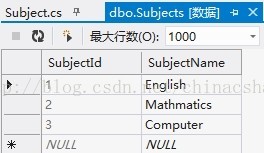Entity Framework多对多关联映射的实现
Entity Framework是微软官方提供的一个ORM解决方案,它有纯正的血统,比NHibernate更容易使用并且与现有其它官方框架配合更加密切。
时代不断的在发展变化,记得10年前还是ADO(配合ASP)的天下,后来微软推出了ADO.NET,再后来推出了ADO.NET Entity Framework,可见微软在.NET与数据库交互领域的作为。
下面我将以Entity Framework(简称EF)来演示一下在C#当中如何使用好这个非常“爽”的ORM工具。我们以大家比较熟悉的模型—学生和课程的多对多的关系(学生可以选择多门课程、课程有可能有多个学生选择)来进行演示。
第一步,建立一个控制台应用程序,起名为CodeFirstEF。我们简单一点,尽量不参杂到其它技术来进行演示,将学习难度降低到最低。
建立一个控制台应用程序没有什么好说的,这里想简单的提一下,使用EF有3种常用的模型,Database-First(数据库优先)、Model-First(模型优先)、Code-First(代码优先)。其中前两种,数据库优先和模型优先是比较简单的两种模型。可以直接通过VS工具连接数据库自动生成与数据库交互的DbContext对象,这种模式有点像我们老早用过的不写一行代码就能自动绑定GridView一样(虽然有点夸张),虽然极大的提高了使用效率,但是灵活度欠缺。因此这篇博客,主要演示代码优先模型,所以起名为CodeFirstEF。
第二步,在CodeFirstEF中建立一个文件夹Entity,里面放置两个模型实体(学生和课程):
namespace CodeFirstEF.Entity { public enum Gender { Female, Male } public class Student { [Key] [DatabaseGeneratedAttribute(System.ComponentModel.DataAnnotations.Schema.DatabaseGeneratedOption.Identity)] public int StudentId { get; set; } public string StudentName { get; set; } public Gender Gender { get; set; } public DateTime? BirthDay { get; set; } public virtual ICollection<Subject> Subjects { get; set; } } }
学生类上面有个枚举,用以区别性别。
namespace CodeFirstEF.Entity { public class Subject { [Key] [DatabaseGeneratedAttribute(System.ComponentModel.DataAnnotations.Schema.DatabaseGeneratedOption.Identity)] public int SubjectId { get; set; } public string SubjectName { get; set; } public virtual ICollection<Student> Students { get; set; } } }
课程和学生类中都有两个虚属性,分别表示学生的课程以及课程有哪些学生。
第三步,添加EntityFramework支持。
两个Entity建好了,下面关键的要添加对EF的引用,这里介绍一个强大的工具NuGet程序包。我们右键点击控制台项目CodeFirstEF,选择管理NuGet程序包,打开下列弹出界面,选择联机,找到EntityFramework。

选择安装EntityFramework。

下载好EntityFramework会弹出窗口。

选择我接受,很快就会装好,装好后如下所示。

点击关闭。这时我们已经为我们的项目添加了EntityFramework支持,可以看到版本号为6,这是目前的最新版本。
第四步,在CodeFirstEF控制台项目下建立一个文件夹DAL,并创建一个数据库操作类DataContext。
namespace CodeFirstEF.DAL { public class DataContext : DbContext { public DataContext(string connectionName) : base(connectionName) { } public DbSet<Student> Students { get; set; } public DbSet<Subject> Subjects { get; set; } } }
它继承自DbContext,需要引用命名空间 using System.Data.Entity。构造函数DbContext有一个参数connectionName,它是用于连接数据库的名称。这时我们切换到App.Config配置文件下,添加connectionStrings节点配置,将数据库连接的配置添加进去。
<?xml version="1.0" encoding="utf-8"?> <configuration> <configSections> <!-- For more information on Entity Framework configuration, visit http://go.microsoft.com/fwlink/?LinkID=237468 --> <section name="entityFramework" type="System.Data.Entity.Internal.ConfigFile.EntityFrameworkSection, EntityFramework, Version=6.0.0.0, Culture=neutral, PublicKeyToken=b77a5c561934e089" requirePermission="false" /> </configSections> <connectionStrings> <add name="codeFirstDb" connectionString="Data Source=.;uid=sa;pwd=123456;Database=CodeFirstDb;" providerName="System.Data.SqlClient"/> </connectionStrings> <startup> <supportedRuntime version="v4.0" sku=".NETFramework,Version=v4.5" /> </startup> <entityFramework> <defaultConnectionFactory type="System.Data.Entity.Infrastructure.SqlConnectionFactory, EntityFramework" /> <providers> <provider invariantName="System.Data.SqlClient" type="System.Data.Entity.SqlServer.SqlProviderServices, EntityFramework.SqlServer" /> </providers> </entityFramework> </configuration>
可以看到里面的codeFirstDb。
好了,这时候让我们看一下整个项目的结构。

第五步,在Program.cs的Main方法中写入测试代码。
namespace CodeFirstEF { class Program { static void Main(string[] args) { using (var db = new DataContext("codeFirstDb")) { //添加学生guwei4037 if (!db.Students.Any(x => x.StudentName == "guwei4037")) { db.Students.Add(new Student() { StudentName = "guwei4037", Gender = Gender.Male, BirthDay = new DateTime(1984, 11, 25), }); } //添加课程 if (!db.Subjects.Any(x => x.SubjectName == "English" || x.SubjectName == "Mathmatics" || x.SubjectName == "Computer")) { db.Subjects.AddRange(new Subject[] { new Subject() { SubjectName="English", }, new Subject() { SubjectName="Mathmatics", }, new Subject() { SubjectName="Computer", } }); } //找到guwei4037这个学生 Student student = db.Students.FirstOrDefault(x => x.StudentName == "guwei4037"); //找到数学和英语这两门课程 List<Subject> subjects = db.Subjects.Where(x => x.SubjectName == "Mathmatics" || x.SubjectName == "English").ToList(); //给学生添加课程 foreach (Subject subject in subjects) { student.Subjects.Add(subject); } //让课程知道有哪些学生选择了它 foreach (Subject subject in subjects) { subject.Students.Add(student); } //删除guwei4037这个学生其中的数学这门课程 student.Subjects.Remove(db.Subjects.FirstOrDefault(x => x.SubjectName == "Mathmatics")); //保存上述操作的结果 db.SaveChanges(); } } } }
很简单,注释也很清晰。
运行一下整个控制台项目,没有报错说明程序运行成功了。我们进数据库查看一下运行的情况。
这里我们也可以利用VS工具来查看,无须打开SQL Server。





我们看到,EF替我们自动创建了数据库CodeFirstDb,并且为我们创建了一张中间表,而且将数据都插入到了相应表中。
怎么样,EF相当强大吧?而且非常简单好用,让你写代码有非常“爽”的感觉。真正的面向对象编程就是这么简单,不用再学习额外的SQL编程了。

